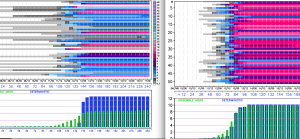I’ve gotten a lot of questions about ensemble models, so I thought this would be a good time to address.
There are the so-called deterministic versions of the models, which you can think of as the headliner versions. These are supposedly the best resolution with the best physic schemes. In addition to the deterministic models, each major global model runs ensemble versions. There is a control run, which is a slightly dumbed down version of it’s big brother deterministic. Then the rest of the ensemble suite is comprise of model runs, which are initial perturbed slightly. The idea is to slightly alter the initial conditions in a manner that represents the inherent uncertainties with weather observation and subsequent reanalysis. So, in the case of the ECMWF (Euro) there are 50 runs in addition to the control run. The motivation here is to eliminate the iterative effects of chaos with extended timesteps in the modeling. What you typically see, long to mid range out, is a wide ensemble spread. As you approach the event, in the short term, your hope is that the ensemble members begin to look like each other.
Let’s look at an example with the current setup. These are side by side comparisons from the ECMWF ensembles from 5 cycles ago and on the right from the current 12Z runs.
First off, I should say…don’t take these totals literally. The Euro treats any frozen precip as “snow”. So for our upcoming event, we are expecting snow and sleet and freezing rain. The quick and dirty rule of thumb of 10:1 snow to liquid ratios will not be valid. These charts show 10:1, chop them at least in half. Again, what’s more important for this discussion is how the ensemble members have come into agreement. (in the charts time moves from left to right, and each bar at the top is the snow accum for each of the 51 ensemble members…the graph at the bottom compares the deterministic snow accum to the ensemble mean.) Note how the deterministic was much above the ensemble mean 5 runs ago. Now they match nicely. Also, note the uniformity of pink on the right in the current run vs. lots of blue and variance on the left. More confidence. All this being said, there are still a lot of big questions. Answers are coming. I promise!
The new 0Z models are rolling in. I’ll put some comments later.

10:33 PM, February 9, 2014Tony Swartz /
Absolutely fascinating. I’m so thankful that you do this. I take your efforts seriously and pass your links on to friends and family. I love your technical approach too. Add in the wit and humor that is “Oh So Trex!” and it’s a masterpiece. Thanks man.
aes
10:34 PM, February 9, 2014Bill Fitzgerald /
Man, I love your stuff but you are going to have to talk in layman’s language if this old goat is going to figure it out. I imagine that something is going to happen but what it is—I don’t know.
12:10 AM, February 10, 2014Mom /
I love reading everything you write about our winter events so I’m always prepared for any snow and ice we will
get in CG!